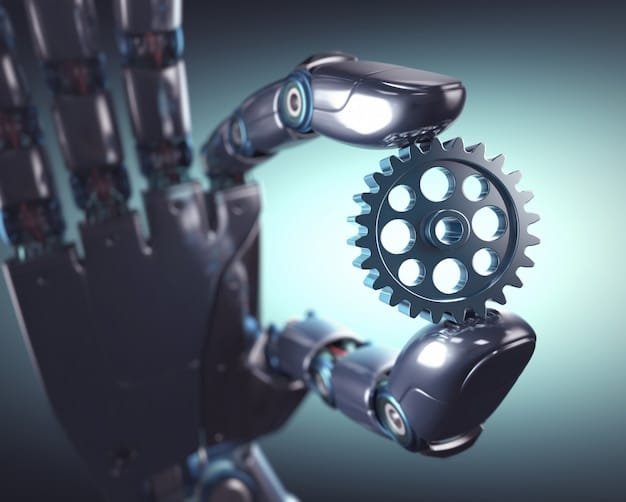Automation Impact on Job Security: Financial Planning Guide

The Impact of Automation on Job Security and Financial Planning involves understanding how technological advancements can reshape employment landscapes and necessitates proactive financial strategies to navigate potential career transitions, skill gaps, and evolving economic realities.
The rise of automation is transforming industries, raising critical questions about the impact of automation on job security and financial planning. This article explores these impacts and offers guidance for navigating the changing landscape.
Understanding Automation and Its Reach
Automation involves using technology to perform tasks that were previously done by humans. Its reach is expanding, impacting various sectors from manufacturing to customer service.
Automation is no longer a futuristic concept; it’s a present-day reality reshaping the job market and influencing financial strategies. To understand its potential impact, we must first grasp the breadth and depth of its application.
The Scope of Automation Across Industries
Automation is not confined to a single sector. It’s permeating industries ranging from manufacturing and logistics to finance and healthcare. Here’s a glimpse:
- Manufacturing: Robots and automated systems handle repetitive tasks, increasing efficiency and reducing production costs.
- Customer Service: Chatbots and AI-powered virtual assistants provide instant support, enhancing customer experience and streamlining operations.
- Finance: Algorithmic trading and automated financial analysis tools are becoming commonplace, improving accuracy and speed.
- Healthcare: Automation aids in diagnostics, robotic surgery, and administrative tasks, optimizing patient care and reducing human error.
The Drivers Behind Automation Adoption
Several factors are driving the widespread adoption of automation:
- Increased Efficiency: Automated systems can operate 24/7, reducing downtime and maximizing productivity.
- Cost Reduction: Automation lowers labor costs, leading to significant savings for businesses.
- Improved Accuracy: Machines can perform tasks with greater precision than humans, minimizing errors and improving quality.
- Enhanced Safety: Robots can handle hazardous tasks, protecting workers from dangerous environments.

The integration of these technologies into various sectors is not just a trend but a fundamental shift in how businesses operate and how individuals engage with their work.
In summary, automation’s widespread adoption is driven by the need for enhanced efficiency, reduced costs, and improved accuracy, influencing job roles and financial planning across multiple industries.
The Impact on Job Security
One of the primary concerns surrounding automation is its potential to displace workers. While some jobs may become obsolete, automation also creates new opportunities.
The introduction of automation has sparked considerable debate and concern regarding its impact on job security. While there are legitimate worries about job displacement, it’s crucial to understand the nuanced ways in which automation is reshaping the employment landscape.
Job Displacement vs. Job Creation
Automation leads to the displacement of workers in roles that involve repetitive, manual tasks. However, it also creates new jobs in areas such as:
- AI Development: Designing, programming, and maintaining AI systems.
- Data Analysis: Interpreting and leveraging the vast amounts of data generated by automated processes.
- Robotics Engineering: Building, installing, and repairing robots and automated equipment.
- Automation Consulting: Helping businesses integrate and optimize automation technologies.
The Skills Gap and Retraining
Automation increases the demand for specialized skills, leading to a skills gap: bridging this gap requires investment in retraining and education programs.
Addressing the skills gap requires a concerted effort from individuals, educational institutions, and employers. Here’s how:
- Individuals: Taking proactive steps to upskill and reskill through online courses, certifications, and vocational training.
- Educational Institutions: Adapting curricula to incorporate emerging technologies and skills needed in the automated workplace.
- Employers: Investing in employee training programs to equip their workforce with the skills to work alongside automation.
The rise of automation underscores the importance of continuous learning and adaptability in maintaining job security. The ability to acquire new skills and adjust to changing job roles will be crucial for navigating the future of work.
To summarize, while automation may lead to job displacement in certain sectors, it also creates new job opportunities that require specialized skills, highlighting the need for retraining and education to bridge the skills gap.

Financial Planning in the Age of Automation
Given the uncertainties surrounding job security, proactive financial planning is essential. This involves building an emergency fund, diversifying income streams, and investing in education.
The evolving job market, influenced by automation, necessitates a proactive and adaptable approach to financial planning. Understanding the potential risks and opportunities is key to securing long-term financial stability.
Building an Emergency Fund
An emergency fund can cover living expenses for several months if you lose your job or face unexpected financial challenges: aim to save at least six months’ worth of expenses.
To build a robust emergency fund, consider the following strategies:
- Set a Savings Goal: Determine the total amount needed based on your monthly expenses and set a target date.
- Automate Savings: Schedule regular transfers from your checking account to your savings account to ensure consistent contributions.
- Cut Expenses: Identify areas where you can reduce spending and allocate those savings to your emergency fund.
- Consider High-Yield Accounts: Explore high-yield savings accounts or money market accounts to maximize the interest earned on your savings.
Diversifying Income Streams
Relying on a single income stream can be risky: explore freelance work, consulting, or passive income opportunities to create multiple revenue sources.
Diversifying income streams can provide a financial cushion and reduce vulnerability to job market fluctuations. Here are some avenues to explore:
- Freelance Work: Offer your skills and services on platforms like Upwork, Fiverr, or Toptal.
- Consulting: Provide expert advice and guidance in your field to businesses or individuals.
- Passive Income: Invest in assets that generate income without requiring active involvement, such as rental properties or dividend stocks.
- E-commerce: Start an online store selling products or services that align with your interests and skills.
Investing in Education and Skills
Investing in new skills and knowledge can increase your marketability and earning potential: pursue online courses, certifications, or advanced degrees to stay competitive.
Investing in your education and skills is an investment in your future. Here are some options to consider:
- Online Courses: Platforms like Coursera, edX, and Udemy offer a wide range of courses on topics ranging from data science to project management.
- Certifications: Obtaining industry-recognized certifications can validate your skills and enhance your credibility.
- Advanced Degrees: Pursuing a master’s degree or doctorate can open up new career opportunities and increase your earning potential.
- Workshops and Seminars: Attending workshops and seminars can provide valuable insights and networking opportunities.
In conclusion, proactive financial planning is crucial in the age of automation: building an emergency fund, diversifying income streams, and investing in education can mitigate risks and enhance financial security.
Government and Policy Responses
Governments have a role to play in addressing the challenges posed by automation, initiatives such as universal basic income (UBI) and enhanced social safety nets may offer solutions.
As automation continues to reshape the job market, governments are exploring various policy responses to mitigate its potential negative impacts and ensure a more equitable distribution of economic benefits.
Universal Basic Income (UBI)
UBI provides a regular, unconditional income to all citizens, regardless of their employment status: it can serve as a safety net for those displaced by automation.
The concept of UBI has gained traction as a potential solution to address income inequality and job displacement caused by automation. Key considerations include:
- Funding Mechanisms: Determining how to fund UBI, whether through taxes, government bonds, or a combination of sources.
- Income Levels: Deciding on the appropriate level of income to provide, balancing affordability with adequacy.
- Eligibility Criteria: Defining who is eligible for UBI, whether all citizens or a subset of the population.
- Economic Impacts: Analyzing the potential impacts on labor supply, inflation, and economic growth.
Enhanced Social Safety Nets
Strengthening social safety nets, such as unemployment benefits and job training programs, can help workers transition to new roles: these initiatives can provide a financial cushion and support retraining efforts.
Governments can enhance social safety nets by:
- Increasing Unemployment Benefits: Providing more generous benefits to help displaced workers meet their basic needs while searching for new jobs.
- Expanding Job Training Programs: Offering comprehensive training programs to equip workers with the skills needed for emerging industries.
- Providing Relocation Assistance: Helping workers move to areas with more job opportunities.
- Investing in Infrastructure: Developing infrastructure projects that create jobs and stimulate economic growth.
Investing in Education and Training
Government investments in education and training programs can equip workers with the skills needed to thrive in an automated economy: focus on STEM fields and vocational training.
To prepare the workforce for the demands of an automated economy, governments should prioritize:
- STEM Education: Investing in science, technology, engineering, and mathematics education to foster innovation and technical skills.
- Vocational Training: Providing hands-on training in trades and technical skills to meet the needs of specific industries.
- Lifelong Learning: Supporting lifelong learning initiatives to enable workers to continuously update their skills.
- Partnerships with Industry: Collaborating with businesses to ensure that education and training programs align with industry needs.
In summary, government and policy responses, such as UBI, enhanced social safety nets, and investments in education and training, can help mitigate the negative impacts of automation and create a more inclusive and prosperous economy.
Adapting Your Skill Set for the Future
To remain competitive in the job market, focus on developing skills that complement automation, such as critical thinking, creativity, and emotional intelligence.
In an era dominated by automation, adapting your skill set is essential for long-term career success. While machines excel at repetitive tasks, uniquely human skills remain invaluable.
Focus on Uniquely Human Skills
Develop skills that are difficult for machines to replicate: these include critical thinking, creativity, emotional intelligence, and complex problem-solving.
To future-proof your career, consider honing the following skills:
- Critical Thinking: Analyzing information, evaluating arguments, and making sound judgments.
- Creativity: Generating new ideas, developing innovative solutions, and thinking outside the box.
- Emotional Intelligence: Understanding and managing emotions, building relationships, and collaborating effectively.
- Complex Problem-Solving: Identifying and solving complex problems using logic, reasoning, and creativity.
Embrace Lifelong Learning
Commit to continuous learning and professional development: take online courses, attend workshops, and stay updated on industry trends.
Lifelong learning is crucial for staying relevant in a rapidly changing job market. Here are some strategies for embracing continuous learning:
- Set Learning Goals: Identify skills you want to develop and set specific, measurable, achievable, relevant, and time-bound (SMART) goals.
- Explore Learning Resources: Take advantage of online courses, workshops, seminars, and industry conferences.
- Join Professional Networks: Connect with peers and mentors to share knowledge and learn from each other.
- Seek Feedback: Ask for feedback from supervisors, colleagues, and clients to identify areas for improvement.
Develop Technical Proficiency
While focusing on human skills is crucial, developing technical proficiency can also be beneficial: learn basic programming, data analysis, or AI concepts to enhance your adaptability.
While uniquely human skills are essential, developing technical proficiency can provide a competitive edge. Consider learning:
- Basic Programming: Understanding programming concepts and languages like Python or Java.
- Data Analysis: Analyzing data to identify trends, patterns, and insights.
- AI Concepts: Learning about artificial intelligence, machine learning, and neural networks.
- Digital Literacy: Developing proficiency in using digital tools and technologies.
In conclusion, adapting skills for the future requires a focus on uniquely human abilities, a commitment to lifelong learning, and the development of technical proficiency, all of which can enhance career resilience and open new opportunities.
Success Stories: Thriving in an Automated World
Many individuals and organizations have successfully adapted to automation. Learning from these examples can provide valuable insights and inspiration.
While the discussion around automation often revolves around potential threats, it’s equally important to highlight success stories of individuals and organizations that have thrived in this environment.
Individuals Who Reskilled Successfully
Highlight examples of workers who successfully transitioned to new roles after being displaced by automation: share their strategies and lessons learned.
Consider the following examples:
- Manufacturing Worker: A former assembly line worker retrained as a robotics technician, leveraging their existing knowledge of manufacturing processes to excel in their new role.
- Customer Service Representative: A customer service representative learned data analysis skills and transitioned to a role as a customer insights analyst, using data to improve customer experience.
- Administrative Assistant: An administrative assistant developed proficiency in project management software and transitioned to a role as a project coordinator, overseeing automated workflows.
Organizations That Embraced Automation
Showcase companies that have successfully integrated automation while supporting their workforce through retraining and new job creation.
Examples include:
- Amazon: While automating warehouse operations, Amazon has invested heavily in retraining programs to help employees transition to new roles within the company.
- Siemens: Siemens has embraced automation in its manufacturing processes while also creating new jobs in areas such as AI development and data analysis.
- Google: Google has invested in initiatives to help workers develop the skills needed for the future of work, including online courses and apprenticeships.
Key Strategies for Success
Identify common strategies used by successful individuals and organizations: these may include proactive learning, adaptability, and a focus on continuous improvement.
Key strategies for thriving in an automated world include:
- Proactive Learning: Taking the initiative to acquire new skills and knowledge.
- Adaptability: Being open to change and willing to adjust to new roles and responsibilities.
- Focus on Continuous Improvement: Continuously seeking ways to improve skills and performance.
- Networking: Building relationships with peers, mentors, and industry experts.
In summary, success stories of individuals and organizations thriving in an automated world demonstrate the importance of proactive learning, adaptability, and a focus on continuous improvement, highlighting the potential for positive outcomes in the face of technological change.
| Key Point | Brief Description |
|---|---|
| 🤖 Automation’s Impact | Automation displaces some jobs but creates new ones, especially in tech-related fields. |
| 💰 Financial Planning | Build an emergency fund, diversify income, and invest in education for financial security. |
| 📚 Adapting Skills | Focus on uniquely human skills like critical thinking and embrace lifelong learning. |
| 政策 Government Support | Governments should consider UBI, enhanced safety nets, and investments in education. |
Frequently Asked Questions (FAQ)
▼
▼
▼
▼
▼
Conclusion
In conclusion, the impact of automation on job security and financial planning is significant, requiring proactive strategies to adapt to the changing landscape. By focusing on continuous learning, developing essential skills, and implementing sound financial planning, individuals can navigate the challenges and thrive in the automated world.





